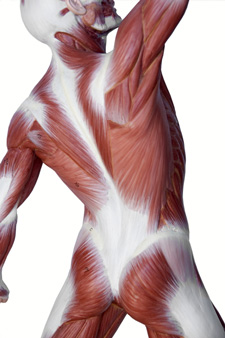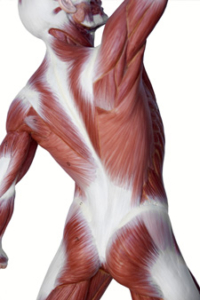I spent the weekend reading a textbook. It was about fascia, and it was a delight.
Fascia is one sheet of tissue on which your entire body is built. In the womb, embryo cells weave this web and attach themselves to it. Throughout life, fascia is woven by fibroblasts, which mold it into bones, ligaments and tendons. The organs and tissues grow onto this scaffolding matrix and fill its spaces. The long sheets of fascia in our bodies are made of collagen fibres, and the paths traced by these strings of tissue are the basis for acupuncture meridians.
Treating fascia is one of the most important elements of effective treatment of injuries, pain and the brain. Stretching, posture and massage all involve fascia. Many physiotherapists and manual therapists have become focused on fascia. But the importance of fascia – and its treatment – are still missing from modern medicine.
Restrictions in fascia can cause pain. They can create numbness and tingling, muscle tightness, spasms, tremors and twitching. Stiffness and joint problems, headaches and TMJ problems can all be fascia-related.
Fascia can also affect the brain. The dura mater is a fascial layer that covers the brain and spinal cord, and a thin layer of fascia coats many nerves in the body. This sac of fascia virtually attaches the brain and spine to the rest of the body.
One of the things that makes our assessment unique is a detailed inventory of all your injuries. We create a visual diagram that highlights all the body parts where restrictions in fascia exist. This gives our patients a tool that they can share with their other providers.
More fascinating to me is the fact that fascia may help explain vibrational medicine. Collagen fibres are piezoelectric. This means that, like crystals, they turn electrical waves into mechanical waves. These mechanical waves transmit pressure, but they also transmit vibration. And these vibrations, which can be felt in the hands and have been measured in labs, are a plausible hypothesis for what some call energy medicine.
The textbook I read is here. But you don’t have to read a whole book to learn more. There are lots of online resources with great pictures of long fascial planes and lines on the body. You can even find gruesome videos of anatomy dissections that show you what it looks like.
Seeing yourself in terms of fascia makes movement more fluid. Muscles work together better, tension is released and posture opens up. Getting your fascia treated can support this change, but it has to start with you.
Be well.


